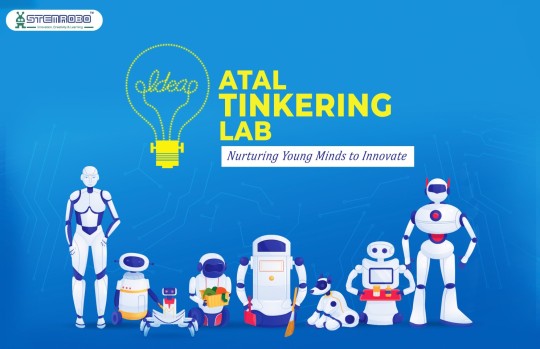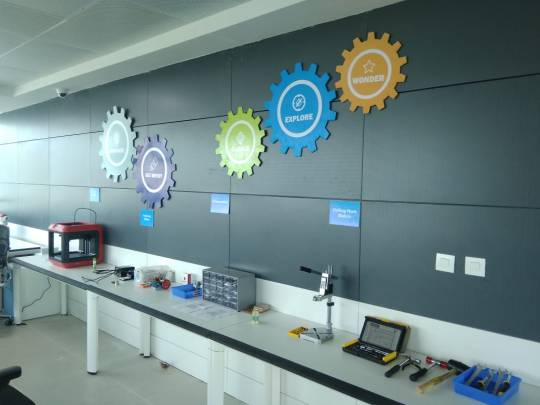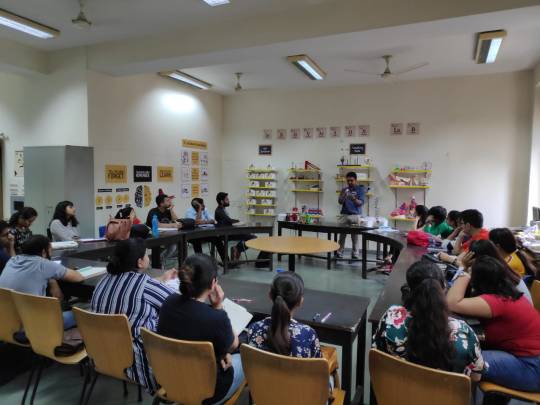#How to Setup ATAL TINKERING LAB
Explore tagged Tumblr posts
Text
#Atal Tinkering Lab#Atal Tinkering Lab setup#Setup Atal Tinkering Lab#How to setup Atal Tinkering Lab#ATL Lab#ATL innovation#Atal tinkering#50k Atal Tinkering Lab
0 notes
Text
A Guide to setting up and maintaining an Atal Tinkering Lab

A Guide to setting up and maintaining an Atal Tinkering Lab
Imagine a space where young innovators can turn their ideas into reality, explore cutting-edge technology, and solve real-world problems. An Atal Tinkering Lab (ATL) offers precisely this a platform for students to engage in hands-on learning and foster creativity. Whether you’re a school leader or an educator, setting up and maintaining an ATL can transform your educational environment. This guide will help you navigate the process effectively.
What Is an Atal Tinkering Lab?
Atal Tinkering Labs are innovation workspaces established under the Atal Innovation Mission by the Government of India. These labs aim to cultivate curiosity and problem-solving among students aged 12–18 by providing access to advanced tools like 3D printers, robotics kits, and IoT devices.
Why Set Up an ATL?
Promotes Experiential Learning: Students learn by doing, not just memorizing.
Encourages Innovation: A space to develop groundbreaking ideas and projects.
Prepares for Future Careers: Exposure to STEM fields and technological skills.
Steps to Set Up an Atal Tinkering Lab
1. Apply for ATL Grants
Schools affiliated with CBSE, ICSE, or state boards can apply for funding through the Atal Innovation Mission. Grants of up to ₹20 lakhs are provided, covering lab setup and operational expenses for five years.
2. Design the Space
Select a Location: Choose a spacious, well-lit area (minimum 1,500 sq. ft.).
Plan the Layout: Divide the lab into sections for ideation, experimentation, and prototyping.
Foster Collaboration: Use open seating, whiteboards, and project displays to encourage teamwork.
3. Procure Equipment
The lab must have tools and technologies such as:
Basic Kits: Screwdrivers, pliers, and soldering tools.
Robotics and Electronics: Arduino, Raspberry Pi, and robotics kits.
3D Printing: Printers and modeling software.
Internet of Things (IoT): Sensors, microcontrollers, and IoT modules.
Make sure all equipment aligns with the guidelines provided by AIM.
4. Recruit Mentors and Trainers
Involve Experts: Collaborate with local engineers, educators, and entrepreneurs.
Train Teachers: Conduct workshops to equip educators with ATL methodologies.
5. Engage Students
Workshops and Competitions: Organize regular sessions to introduce students to ATL tools.
Innovation Challenges: Host hackathons or themed competitions to inspire creativity.
Maintaining an ATL
1. Regular Equipment Upkeep
Inspect tools and machines periodically.
Replace damaged or outdated equipment promptly.
2. Monitor Usage
Maintain logs of student projects and equipment usage.
Encourage responsible handling of tools.
3. Continuous Training
Organize refresher workshops for teachers and mentors.
Stay updated with the latest technology trends.
4. Promote Community Engagement
Partner with local organizations for sponsorships or mentorship.
Showcase student projects in exhibitions and online platforms.
Success Stories
Smart Irrigation System: A student group designed a system to monitor soil moisture and automate irrigation, benefiting local farmers.
Disaster Alert App: A team developed an app that sends alerts during floods, earning recognition at a national level.
Challenges and How to Overcome Them
Funding Limitations
Seek additional sponsorships from local businesses or alumni networks.
Low Participation
Introduce ATL activities into the regular curriculum to boost student involvement.
Skill Gaps in Teachers
Partner with ed-tech companies for training programs.
Start building your Atal Tinkering Lab today!
Are you ready to revolutionize education with an Atal Tinkering Lab? Start today and empower students to innovate, create, and solve real-world challenges. Together, let’s build a future where learning knows no boundaries.
Transform your school into a hub of innovation Speak to an Expert Now!
0 notes
Link
What are ATAL Tinkering Labs (ATL)?
Atal Tinkering Lab (ATL) is a central government of India initiative to create an environment of scientific temperament, innovation, creativity amongst Indian students. It is a step towards a new India that will embrace and encourage novel and innovative ideas and inventions.
Similarly, Atal Innovation Mission Background NTII Aayog’s flagship program, Atal Innovation Mission (AIM) including Self-Employment and Talent Utilization (SETU) are Government of India’s endeavour to promote a culture of innovation and entrepreneurship. The objective of these programs is to serve as a platform for promotion of world-class Innovation Hubs, Grand Challenges, Start-up businesses and other self-employment activities, particularly in technology driven areas.
#How to Setup ATAL TINKERING LAB#Setup ATAL TINKERING LAB#Setup ATAL TINKERING LAB at your School#ATAL TINKERING LAB#ATAL TINKERING LAB at your School
0 notes
Text
Why Atal Tinkering Lab Is The Best Choice For Schools?
Atal Tinkering Lab is a type of workplace that consists of modern 21st century-based tools and equipment that nurture an innovative mindset among young minds. The main objective of setting up an ATL lab in school is to promote curiosity, imagination, and creativity so that the kids can bring their innovative ideas to life.
What Is The Eligibility Criteria For Getting An Atal Tinkering Lab Setup in Schools?
In order to establish an ATL lab in schools, it must be managed by the Government, local body, or by a private society.
The schools that have applied for the Atal tinkering lab, must provide at least 1500 square feet of built-up space for the ATL lab setup.
In the case of schools that are located in hilly/Himalayan and Island states or union territories, the school has to provide a built-up space of 1000 square feet.
What Type Of Financial Support Is Provided By AIM To Eligible Schools?
Atal Innovation Mission(AIM) provides grant-in-aid to eligible schools that cover a 1-time set-up cost of Rs. 10 Lacs along with providing the operational expenses of Rs. 10 lacs for a maximum duration of 5 Years.
What Is The Selection Process of Schools for the Atal Tinkering Lab setup?
If there is a school that wishes to establish an Atal Tinkering Lab on its premises, they have to go through a selection process that has been devised by the Atal Innovation Mission(AIM). The applicant schools have to go through a rigorous challenge-based process for the purposes of selection. The applicant schools are screened on the basis of the application form they fill out online. This applicant application is sent to the official AIM through the website portal.
Let’s talk about the selection process of schools for ATL lab setup:
Step-1: Submit Applications Via Online Portal
Step-2: School Applications Screenings
Step-3: Final Evaluation Process
What Are The Benefits Of Having an Atal Tinkering Lab In Your School?
To stimulate the spirit of competitiveness among students, Atal Tinkering Lab in schools conducts a wide range of regional and national level competitions, exhibitions, and workshops on problem-solving at regular intervals of time.
Technology is evolving at a rapid rate. With the help of the ATL lab in schools, the students will learn about current advancements in the field of AI and automation.
It strengthens students’ research and problem-solving skills and makes them active learners.
The students will learn from their mistakes and find multiple solutions to solve a particular problem.
What Is The Importance Of Atal Tinkering Lab?
The ATL lab in school helps to create a learning ecosystem that teaches young minds 21st-century skills such as adaptive learning, computational skills, better decision-making, and problem-solving skills. These skills give young minds the ability to excel in their careers no matter which field they choose and also spark their interest in STEM(Science, Technology, Engineering, and Technology).
Why Choosing Tinkerly Powered ATL Tinkering Lab for School Is The Best Choice?
Tinkerly is a registered vendor on GeM(Government E-Marketplace) to establish ATL labs in schools that are sponsored by NITI Aayog. The Atal Tinkering Lab that is powered by Tinkerly consists of 160+ tools like Do-it-yourself kits, 3D printers, scientific types of equipment, Robotics toys, science DIY kits, electrical and mechanical equipment, and other consumables as per NITI Aayog guidelines.
How does Tinkerly Provide Training & Support To ATL Schools?
Given below are the ways using which Tinkerly provides training & support to the ATL lab in schools.
Expert Research & Development Team
Tinkerly has an expert Research & Development team that belongs to prestigious IITs and NITs. They provide the best content by using their knowledge and expertise.
5 Years of Complete Guidance To ATL Schools
The best thing about Tinkerly-powered Atal Tinkering Lab is that the team provides 5 years of complete guidance and AMC(Annual Maintenance Contract)/Dashboard support.
Training & Support
They provide 3 days of training on content equipment and other operational processes. Also, conduct online webinars once a week. Also, conduct online webinars once a week. Also, the tinkerly team provides 13×7 online/on-call support and also handles all types of queries.
Year-long STEM activities:
Tinkerly conducts year-long STEM activities that encourage the spirit of competition among young minds. They give exposure to the world-class research environment to young minds.
Along with all the above things, the team tinkerly also gives marketing support and consultation. Also, level-wise content mapped with diverse skills are also provided by the team. To add fun and seek the interest of children, session plans and challenge cards are used.
A class-wise activity plan along with guidelines for teachers/students are also shared with students.
Technology is evolving at a rapid rate. With the help of the ATL lab in schools, the students will learn about current advancements in the field of AI and automation. It strengthens students’ research and problem-solving skills and makes them active learners. The students will learn from their mistakes and find multiple solutions to solve a particular real-life problem.
Summing Up!
In this blog, we have discussed the benefits of setting up an Atal Tinkering lab for schools and how it helps to enlighten student’s innovative skills.
For More Info:- atl tinkering
0 notes
Text
Indian Union Budget 2025: Govt to Establish Atal Tinkering Labs in 50,000 Schools
The Union Budget 2025 has set a remarkable precedent for the future of education in India with the ambitious plan to establish Atal Tinkering Labs (ATL) in 50,000 schools over the next five years. This initiative is not just about creating spaces; it’s about fostering innovation and creativity among students. The ATL Lab setup will empower young minds to explore, experiment, and engage in hands-on learning experiences that are crucial for developing critical thinking and problem-solving skills.
So, how can schools participate in this transformative journey? Setting up an Atal Tinkering Lab involves a straightforward application process that interested institutions can follow. Schools must demonstrate their commitment to nurturing innovation through a well-structured proposal detailing their vision for the lab.
Once approved, the ATL Lab setup will provide access to state-of-the-art tools and resources designed to encourage students to tinker with technology and unleash their creativity. Educators will also receive training on how to effectively utilize these labs as platforms for exploration.
For those wondering how to apply for an Atal Tinkering Lab setup, it’s essential to stay informed about announcements from the government regarding application windows and requirements. This is an extraordinary opportunity not only for schools but also for students who aspire to become future innovators. By embracing this initiative, we are investing in a generation that will drive India’s technological advancements forward.
Setting up an Atal Tinkering Lab after receiving the grant requires careful planning and execution. By following a systematic approach, you can ensure the successful establishment of a vibrant and innovative learning space for students.
The first step is to create a detailed implementation plan. This involves identifying the location for the lab, assessing the infrastructure requirements, and allocating resources such as equipment, tools, and materials. It is essential to consider factors like accessibility, safety measures, and availability of utilities during this stage.
Next, it is crucial to form a dedicated team of mentors and instructors who will guide students in their tinkering journey. These individuals should have expertise in various domains like science, technology, engineering, arts, and mathematics (STEAM). They will play a pivotal role in fostering creativity and critical thinking among students.

Once the team is assembled, it's time to procure the necessary equipment and materials for the lab. This may include electronics components, robotics kits, 3D printers, software licenses, and other relevant resources. Careful consideration should be given to selecting high-quality tools that align with the curriculum objectives.
After setting up the physical infrastructure and acquiring resources, it's important to design a comprehensive curriculum that integrates hands-on learning experiences with theoretical knowledge. The curriculum should be flexible enough to cater to different age groups and skill levels while promoting innovation and problem-solving skills.
In parallel with curriculum development comes teacher training programs. Conducting workshops or training sessions for educators will empower them with the necessary skills to effectively facilitate tinkering activities within the lab. This training can cover topics such as project-based learning methodologies or specific technical skills related to STEAM subjects.
Lastly but equally important is establishing partnerships with industry experts or local organizations that can provide mentorship opportunities or collaborate on real-world projects with students at your Atal Tinkering Lab. These collaborations will expose students to practical applications of their knowledge while fostering an entrepreneurial mindset.
By following these necessary steps, you can ensure a successful setup of an Atal Tinkering Lab that will empower students to become innovators, problem solvers, and future leaders in the fields of science and technology.
The Indian Union Budget 2025 has introduced a visionary initiative aimed at revolutionizing the education landscape by setting up Atal Tinkering Labs (ATLs) in 50,000 schools across the country over the next five years. This move aligns with the government’s broader mission of fostering innovation, creativity, and technological advancement among young learners.
A Step Towards Innovation-Driven Learning
The establishment of ATLs is more than just creating spaces with modern equipment; it is about instilling a culture of innovation and hands-on learning. These labs will serve as hubs for young minds to explore, experiment, and develop problem-solving skills through interactive and practical experiences. By integrating technology and real-world applications into the learning process, students will be better equipped to tackle challenges and contribute to India's growing innovation ecosystem.
How Can Schools Participate in Atal tinkering lab setup?
The government has streamlined the process for schools to apply for setting up Atal Tinkering Labs. Institutions keen on joining this transformative journey need to follow a structured application process, which includes:
1. Submitting a Proposal: Schools must demonstrate their commitment to fostering innovation by presenting a well-documented proposal outlining their vision, objectives, and implementation strategies for the ATL Lab.
2. Selection and Approval: After review, selected schools will receive approval and funding assistance to establish the labs within their premises.
3. Infrastructure Setup: Schools will be provided with state-of-the-art tools and equipment, including 3D printers, robotics kits, electronics, and mechanical components, allowing students to engage in hands-on experiments and prototype development.
Empowering Educators and Students
Beyond infrastructure, the initiative also focuses on capacity building. Educators will undergo specialized training programs to effectively utilize ATLs as interactive learning platforms. These training sessions will help teachers guide students in developing innovative projects and practical applications, ensuring the labs serve as dynamic learning environments.
The Road Ahead
With the implementation of 50,000 Atal Tinkering Labs, India is set to take a significant leap towards an innovation-driven education system. This initiative not only nurtures the next generation of thinkers, creators, and entrepreneurs but also strengthens India’s position as a global leader in science and technology. Schools embracing this initiative will play a crucial role in shaping future innovators who will drive the nation’s progress.
As the government rolls out this ambitious plan, educational institutions have a golden opportunity to be at the forefront of this transformation. The future of education in India is set to become more dynamic, practical, and innovation-focused, paving the way for a new era of technological excellence.
More Details visit : https://www.stemrobo.com/atal-tinkering-lab/
#Atal Tinkering Lab#Atal Tinkering Labs#Atal Tinkering Lab Setup#Atal Tinkering Lab in school#ATL Lab#ATL Lab setup#Atal Tinkering Lab for students
1 note
·
View note
Text
The growing popularity of STEM labs in India

Imagine a classroom where students are not just passive listeners but active creators, building robots, designing apps, and conducting experiments that bring their textbooks to life. This is the transformative power of STEM (Science, Technology, Engineering, and Mathematics) labs. In recent years, STEM labs have gained immense popularity in India, revolutionizing traditional education methods and equipping students with skills that prepare them for the future.
What Are STEM Labs?
STEM labs are innovative spaces equipped with modern tools and technology that foster hands-on learning. They allow students to explore concepts through practical applications, bridging the gap between theory and real-world problem-solving. These labs often feature 3D printers, robotics kits, coding platforms, and experimentation setups that make learning interactive and engaging.
The Rise of STEM Labs in India
India, with its rich talent pool and increasing focus on innovation, has embraced STEM education as a means to empower the next generation. Here are some key factors driving the popularity of STEM labs:
Government Initiatives: Programs like Atal Tinkering Labs (ATL) under the Atal Innovation Mission have established thousands of STEM labs in schools across the country. These initiatives aim to cultivate curiosity and innovation among young learners.
Demand for Future-Ready Skills: With rapid advancements in technology, the job market demands skills like coding, analytical thinking, and engineering. STEM labs provide students with early exposure to these essential competencies.
Collaborations with EdTech Companies: Many education technology companies are partnering with schools to set up STEM labs. These collaborations bring cutting-edge resources and expertise into the classroom.
Parental Awareness: Parents in India are increasingly aware of the importance of STEM education. They see STEM labs as a way to give their children a competitive edge in academics and careers.
Impact on Education
STEM labs are reshaping the education landscape in India by:
Promoting Experiential Learning: Students learn by doing, which enhances their understanding and retention of concepts.
Fostering Creativity: By encouraging experimentation, STEM labs nurture creative problem-solving skills.
Bridging the Gender Gap: Initiatives like ATL aim to make STEM education accessible to girls, promoting gender equality in technology and science fields.
Encouraging Collaboration: Group projects in STEM labs teach students teamwork and communication skills.
Real-Life Success Stories
A group of students in Bengaluru used their STEM lab to design a water purification system for their community.
In a rural school in Maharashtra, girls created an app to help local farmers monitor crop health, showcasing how STEM labs can drive social impact.
Challenges and the Way Forward
Despite the growing popularity, there are challenges in implementing STEM labs, such as limited resources in rural areas and a lack of trained educators. To overcome these, stakeholders must:
Invest in teacher training programs.
Provide funding and support for underprivileged schools.
Create awareness campaigns to highlight the importance of STEM education.
Bring STEM innovation to your school
STEM labs are not just a trend; they are a necessity in modern education. These labs are nurturing innovation, encouraging creativity, and enhancing critical thinking, paving the way for India’s future leaders and visionaries. As more schools adopt STEM labs, the possibilities for young minds are endless, and India is poised to become a global hub for technology and innovation.
Want to bring the power of STEM to your child’s school? Explore how Makers Muse can help set up state-of-the-art STEM labs tailored to inspire and educate. Visit Makers Muse today!
0 notes
Text
1 note
·
View note
Video
youtube
How to Setup ATAL TINKERING LAB at your School || OFFERINGS BY STEMROBO
Application for Atal Tinkering Laboratories : With a vision to ‘Cultivate one Million children in India as Neoteric Innovators’, Atal Innovation Mission is establishing Atal Tinkering Laboratories (ATLs) in schools across India. The objective of this scheme is to foster curiosity, creativity and imagination in young minds; and inculcate skills such as design mindset, computational thinking, adaptive learning, physical computing etc.
Contact For more Details : https://www.stemrobo.com/atal-tinkering-labs/
Key Features of ATL : ATL is a work space where young minds can give shape to their ideas through hands on do-it-yourself mode; and learn innovation skills. Young children will get a chance to work with tools and equipment to understand the concepts of STEM (Science, Technology, Engineering and Math). ATL would contain educational and learning ‘do it yourself’ kits and equipment on – science, electronics, robotics, open source microcontroller boards, sensors and 3D printers and computers. Other desirable facilities include meeting rooms and video conferencing facility. In order to foster inventiveness among students, ATL can conduct different activities ranging from regional and national level competitions, exhibitions, workshops on problem solving, designing and fabrication of products, lecture series etc. at periodic intervals. Financial Support : AIM will provide grant-in-aid that includes a one-time establishment cost of Rs. 10 lakh and operational expenses of Rs. 10 lakh for a maximum period of 5 years to each ATL. Eligibility : Schools (minimum Grade VI - X) managed by Government, local body or private trusts/society to set up ATL. For more information, please refer to the guidelines attached below. Schools desirous to establish ATLs may submit their application online to the Atal Innovation Mission, NITI Aayog through the link given below.
https://www.stemrobo.com/atal-tinkering-labs/
#How to Setup ATAL TINKERING LAB#How to Setup ATAL TINKERING LAB at your School#Leading ATL Lab Setup Vendor#Atl Lab setup
1 note
·
View note
Text
Benefits Of Setting Up Atal Tinkering Lab In Your School
Atal tinkering lab is a workspace where children get a chance to bring their creative ideas to life by using a hands-on learning approach. This atal tinkering lab model consists of educational DIY kits and equipment based on science, electronics, robotics, 3D printers, etc. that teaches students the concept of STEM in a fun and interactive manner.

What Do You Mean By Atal Tinkering Lab?
To create an environment of innovation among children, Govt. of India has come up with a flagship initiative under the AIM(Atal Innovation Mission) by NITI Aayog known as the Atal Tinkering Lab. The main aim of Atal Tinkering Lab is to "Cultivate 1 Million Young Minds in India as Neoteric Innovators".
How does Tinkerly help to set up Atal Tinkering Labs in Schools?
Many well-known edtech companies provide assistance to set up ATL labs in schools. In all of those edtech companies, Tinkerly is among one of them.
Tinkerly is a registered vendor on "Govt. E-Marketplace(GeM) to establish atal tinkering labs sponsored by NITI Aayog. The company provides an end-to-end solution for schools that consists of lab setup, and a coding curriculum as per NEP guidelines. The lab consists of 160+ tools like DIY kits, 3D printers, robotics, mechanical, electrical equipment, and other types of consumables according to the NITI Aayog guidelines.
What are the Tinkerly's Offering In Establishing Atal Tinkering Lab In Schools?
While setting up the Atal Tinkering lab in schools, Tinkerly offers the following offerings:
Support: They provide support 13x7 Online/On-call to various types of technical queries the school might be facing.
AMC: They provide 5 years of complete guidance & support for the AMC dashboard.
Training: They provide 3 days of training on how to use tools and equipment, content, and operational process.
Team of Experts: They and an excellent Research & Development team that belong to various prestigious IITs and NITs that help to develop good quality content as per NEP guidelines for the students.
STEM connectivity: They are involved in organizing year-long STEM activities with various academic and research institutes that give exposure to the world-class research environment.
Marketing Support: They provide the necessary marketing support and consultation to the schools.
Curriculum & Lab Manual:
They provide level-wise content that is mapped with various skills. It accompanies a class-wise activity plan and provides guidelines for teachers & students. To enhance the fun and make the learning atmosphere more exciting, challenge cards are used based on various STEM-related activities.

Benefits Of Setting Up Atal Tinkering Lab In Your School
The advantages offered to the students are listed down below:
They will get expert guidance from mentors
They will gain knowledge about innovative technologies like AI, IoT, and Robotics.
They will understand the practical relevance of STEM concepts by using the tools and equipment that are available in the atal labs.
They will be introduced to Hands-on learning through Science DIY kits using which they can discover the power of creativity and logic.
They are not limited to the limitations of learned words but they develop a natural inclination towards innovating and coming up with new ideas.
The students are introduced to learning beyond the academic subjects.
Timely competitions are held that encourage students to showcase their talent in the form of various real-life projects.
Summing Up!
In this blog, we have learned about the benefits of setting up Atal tinkering labs in schools. We also talked about the offerings of Tinkerly-powered Atal tinkering labs and the benefits they offer to the schools.
For more Info:- stem education
0 notes